Affordable Surfboards for Beginners: A Complete Guide
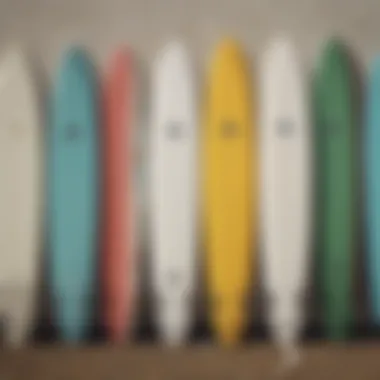
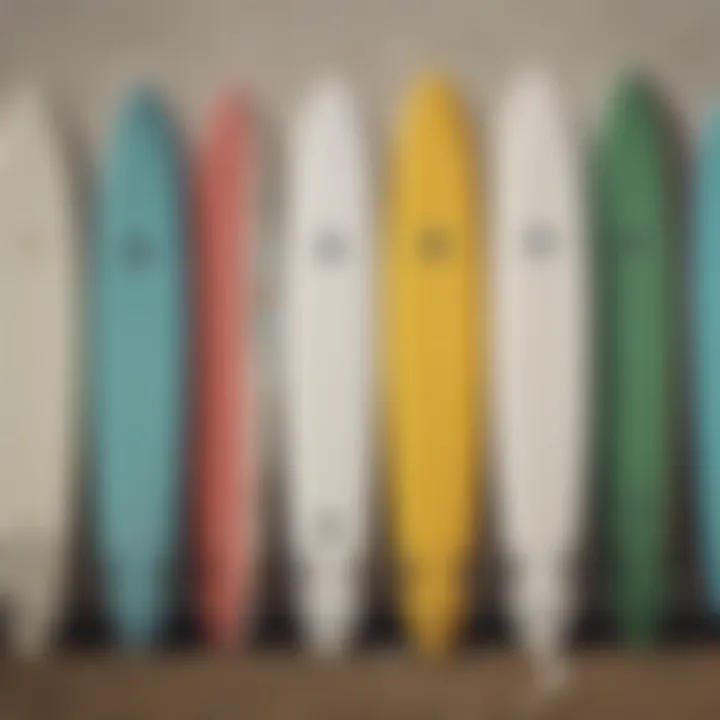
Intro
Surfing is not just a sport; it’s a lifestyle. For many, the mesmerizing dance of catching waves brings a sense of freedom and exhilaration unlike anything else. However, stepping into the world of surfing might seem a bit daunting, particularly when faced with the myriad of choices available, like surfboards, gear, and techniques. The aim of this guide is not just to drop you into the sea but to equip you with the knowledge that allows you to ride those waves with confidence.
When it comes to affordable surfboards, understanding what to look for can turn the tides in your favor. Whether you're a fresh-faced beginner or someone looking to dip your toes with a budget in mind, knowing the types of boards, the most critical features, and where to snag the best deals can make the difference between floundering in the water or hitting those perfect waves. Let’s take a dive into the essentials that will help you paddle out with the right gear and mindset.
Gear Recommendations
Essential Gear for Beginners
Choosing the right surfboard is the first step on your wave-riding journey. Here are some essential items that will help ensure you have a smoother glide through the learning process:
- Soft-top Surfboard: Ideal for beginners, these boards are forgiving, preventing injuries when you inevitably take a tumble. Their buoyancy and stability make for easier paddling and riding. Look for brands like Wavestorm or Catch Surf that offer decent quality without burning a hole in your wallet.
- Leash: A leash keeps your board close by when you wipe out, preventing it from becoming a hazard for others.
- Wetsuit: Depending on your location, a wetsuit protects against cold water and helps with buoyancy. If you’re in warmer waters, a shorty wetsuit should suffice. Look for affordable options from O'Neill or Roxy.
- Wax: Surfboard wax provides the grip you need to stay on your board while riding. It’s inexpensive and an absolute must-have. Look for a tropical or cool water wax depending on the conditions.
Advanced Equipment for Professionals
While the focus here is on beginners, it’s useful to briefly touch on what more experienced surfers might consider as they evolve:
- Performance Shortboard: For those who have honed their skills and are looking to push their limits. These boards are smaller and designed for advanced maneuvers.
- Fish Board: Great for speed and maneuverability, these boards are perfect for someone looking to cut through smaller waves with skill.
- Stand-up Paddleboard (SUP): If you’re exploring beyond surfing, a SUP offers balance training and a full-body workout, benefiting all water sports.
Techniques and Tips
Skill Improvement Strategies
It’s all about practice, and finding effective ways to improve can enhance your surfing experience:
- Take Lessons: While learning on your own is part of the journey, professional lessons can provide you with tailored feedback that’s priceless.
- Observe Others: Watch more experienced surfers. Notice their techniques and how they read the waves.
- Practice Balance: Off the water, practice balance exercises. The better your balance, the easier it will be to ride.
- Stay Positive: Everyone wipes out; how you approach these moments will shape your growth. Learn from your mistakes and keep trying.
Safety Practices and Guidelines
Safety is paramount in surfing, as it ensures not just your wellbeing but تلك التي around you as well:
- Know Your Limits: Don’t venture into challenging waters too soon. Build your skills progressively.
- Watch for Rip Currents: Understanding ocean conditions can save your life. Familiarize yourself with how to identify and handle rip currents.
- Surf with a Buddy: Always have someone around when you surf, especially when you're a beginner.
"Successfully riding the waves is as much about your mindset as it is about your skills. A calm and prepared surfer is a safer surfer."
Epilogue
In the end, the journey into surfing is about understanding the art of balance—between choosing the right board, applying techniques, and maintaining safety. With the insights provided in this guide, aspiring surfers armed with the right gear and a positive mindset are ready to take the plunge into this exhilarating world. The waves await, and with them, countless adventures that stretch beyond the horizon.
Understanding the Basics of Surfboards
When jumping into the world of surfing, grasping the basics of surfboards feels essential. Not just some fancy equipment, surfboards serve as your primary tool to navigate the waves. Understanding their construction and types can guide you in making more informed decisions, especially for beginners who often find themselves overwhelmed with options. Plus, knowing what each part does can squarely help you tailor your surfing experience, ensuring the ride matches your unique style.
The Anatomy of a Surfboard
A surfboard might seem straightforward, but every component plays a crucial role in how you'll interact with the water. Distinguishing between its parts will elevate your surfing game and contribute to your safety on the waves.
Deck
The deck is the top surface of the surfboard. It's where you stand during your ride. A key characteristic of the deck is its traction, typically enhanced by a grip pad or wax to prevent slips. For newcomers, this feature becomes immediately beneficial as it allows for stability while learning to balance on the board. A unique aspect of the deck is its foam or fiberglass construction, which can influence the board's weight and buoyancy. The lighter the board, the easier it can be to maneuver. However, fragility can be a downside if it’s not well taken care of, making regular maintenance essential.
Bottom
The bottom of the surfboard is where the action happens—the part in direct contact with the water. One notable aspect of the bottom is its shape. From flat surfaces that aid beginners in getting used to paddling, to concave designs that enhance speed for more experienced surfers, understanding the bottom’s layout can impact how you ride.
Different contours on the bottom serve distinct purposes; for example, a rounded bottom provides stability, while a more pointed direction may offer speed. This unique feature can be a double-edged sword—what brings form to a novice might invite difficulty for seasoned surfers.
Fins
Fins are attached to the bottom and are often overlooked by beginners. However, they are a vital part of the board's design. A primary characteristic of fins is their ability to provide directional control. For starters, surfboards can have a single fin, or multiple fins in various configurations. This choice significantly alters how a board performs on waves. Fins can be made of different materials, such as fiberglass or plastic, with varying levels of rigidity affecting their performance. Choosing a well-designed fin setup can make a practical difference, contributing positively to balance and turning ability.
Tail
The tail is another pivotal part of the board. It's the back end and plays a significant role in speed and control. For beginners, selecting a wider tail can provide extra stability, making it easier to paddle and ride waves. On the other hand, a narrow tail can facilitate sharper turns, which might be favorable for more experienced surfers. The unique feature of the tail is its shape; whether it’s a squash, pin, or swallows tail, each influences maneuverability and speed in different ways. The downside comes when an ill-suited tail shape can hinder progression in skills.
Types of Surfboards
When selecting your first surfboard, it's paramount to understand the various types available. Each type caters to different styles, conditions, and skills, which plays a vital role in your surfing experience.
Shortboards
Shortboards are typically more agile and responsive, favored by more seasoned surfers. This type shines in high-performance waves, aiding in quick turns and tricks. However, their shorter length can pose a challenge for beginners still learning to balance and catch a wave. But, once you get the hang of it, this surfboard can feel like a magic carpet ride.
Longboards
The longboard, often regarded as the classic surfboard, offers a greater surface area which translates to improved stability. They are excellent choices for beginners, as they're generally easier to paddle and catch waves on. The unique feature here is the glide they provide; you can feel like you're cruising on a long ride through the water. However, their size might come with challenges when navigating crowded surf spots.
Fish Boards


Fish boards are unique due to their wide-body and shorter length. They perform exceptionally well in smaller, weaker waves. A key characteristic is the split tail design, which increases maneuverability. For beginner surfers, this type can teach valuable lessons in balancing and riding flows smoothly. However, they can be quite different from the traditional longboard, potentially causing confusion for those who are still unsure of what feels comfortable.
Soft Top Boards
Soft top boards have gained popularity with beginners due to their forgiving nature. Their soft surface reduces the risk of injury, encouraging new surfers to feel secure and build confidence. This type is usually lightweight and buoyant, making it easier for newcomers to paddle. But they can be slower than traditional hard-top boards, which might deter some users looking for speed. Choosing the right surfboard sets the stage for a thrilling surfing adventure ahead.
Why Choose a Cheap Surfboard?
When stepping into the world of surfing, the choices in surfboards can feel as vast as the ocean itself. However, opting for a budget-friendly surfboard can offer numerous advantages for beginners that far outweigh the initial hesitation about quality or performance. Affordability becomes a significant factor for those just starting out, as it allows for experiments without breaking the bank.
Affordability for Beginners
One of the primary reasons for choosing a cheaper surfboard is, without doubt, the affordability. Stretching a tight budget is often a necessity, especially for newcomers who want to dip their toes into the surfing scene without diving headfirst into financial commitments. A reasonably priced board not only keeps costs manageable but also reduces the pressure of making the "perfect" purchase right away.
Investing in an entry-level board continues to be a wise move. Beginners can use these boards for practical purposes—testing their skills, trying out various techniques, and figuring out what type of board truly suits their riding style. If all goes well and surfing quickly becomes a passion, upgrading to a more advanced model is always an option down the line. Choosing these economical boards also grants peace of mind, knowing that you are not constantly on edge about damaging a high-end piece of equipment.
"The best surfboard for a beginner is the one that doesn’t cost an arm and a leg, allowing them to focus on mastering the waves, not worrying about their wallet."
Trial and Error
Another compelling aspect of starting with a cheap surfboard is the room for trial and error. Surfing is not just a sport; it’s an art form that often requires practice and patience. No one hops on a board and rides like a pro right off the bat. There’s much learning that occurs in the process.
By investing in a more affordable surfboard, beginners can freely experiment with their technique. You might find yourself at a local beach attempting new tricks and approaches without the fear of damaging an expensive board. Additionally, each fall or wipeout is an opportunity to learn and evolve as a surfer. As you make a number of choices, from wave selection to positioning on the board, it’s helpful to do so on a more forgiving piece of equipment.
In summary, both affordability and the opportunity to learn through trial and error make choosing a cheap surfboard a sensible option for beginners. It allows for a more relaxed, enjoyable experience while transitioning into this thrilling sport, all the while setting the stage for possible future upgrades as their confidence takes flight.
Key Features to Look for in Beginner Surfboards
When delving into the world of surfing, especially for beginners, understanding the essential features of a surfboard can significantly enhance the experience. Choosing a board that caters to novice needs means considering various factors that can either aid or hinder one’s progression on the waves.
A beginner surfboard should promote stability, simplify paddling, and ultimately encourage a faster learning curve. By focusing on specific features, newcomers can avoid frustrations and focus instead on enjoying the thrill of catching waves.
Stability and Floatation
Stability is paramount for anyone taking their first steps into surfing. A surfboard that’s too wobbly can lead to quick wipeouts, which can deter even the most enthusiastic novice. A board with a broader width and a flatter rocker will provide a more stable platform, making it easier to balance while standing up.
Floatation is equally important. For starters, a board with ample volume creates a buoyant surface that keeps it afloat, thus enabling easier paddling and wave-catching. Less effort spent paddling means more time riding. Look for boards that prioritize both stability and floatation for a more forgiving entry into the sport.
Material Considerations
When considering materials, two types typically stand out in the discussions: foam and fiberglass. Each has merits and drawbacks.
Foam versus Fiberglass
Foam boards are undeniably friendly for beginners. Their lightweight nature allows for easy maneuverability in the water. Additionally, foam boards are more forgiving in terms of impacts.
A particularly appealing characteristic of foam boards is their soft surface, which minimizes the risk of injury. This makes them a popular choice for those just starting out. However, they can be less durable over time in harsher environments, like rocky beaches.
Conversely, fiberglass boards offer a stronger, more resilient choice. They cut through the water more efficiently and can provide better performance as the beginner hones their skills. That said, they can be a bit of a burden if dropped or struck as they tend to chip or shatter more easily.
Durability Factors
Durability is another crucial aspect to consider. Beginners may take a few tumbles as they learn to ride properly. Thus, selecting a surfboard that withstands a bit of rough treatment is invaluable.
Fiberglass boards, while they have the potential to be more lasting, require careful handling. Foam boards, on the other hand, might sustain more wear due to abrasions or collisions, but their overall resilience to lighter bumps can assist beginners.
Buying a board that suits the intended environment is key. For example, if one plans to surf mostly in rougher waters or rocky areas, a more durable fiberglass board might be wiser. Yet, if the goal is simply to enjoy calm days at the beach, a foam board could suffice.
Size Recommendations
Finally, size must not be ignored. A proper surfboard dimension significantly influences a beginner’s ability to stand up and ride. Typically, a longer board makes it easier to paddle and balance. New surfers generally benefit from boards that are longer, wider, and thicker as these characteristics enhance floatation and paddle efficiency. A good rule of thumb? Aim for a board approximately 6 to 8 feet long. Avoid shortboards as they can be a real challenge in terms of stability.
Getting the size right means you’ll feel more at ease on the water, leading to a more enjoyable surfing experience. As you become more proficient, there’s always room to explore different sizes and shapes.
Learning to surf can feel daunting at first, but with a solid grasp of essential features—stability, materials, and size—new surfers can find the perfect board suited for their skills. This can set the stage for a rewarding surfing journey.
Top Affordable Surfboards for Beginners
Finding the right surfboard can make or break the surfing experience for novices. Affordable surfbords tailored to beginners not only enhance skill development but also provide a solid foundation for a lifelong passion. These choices don’t compromise on performance while being easy on the wallet. When diving into the world of surfing, it’s crucial for beginners to grasp that not all surfboards are created equal. The right board can instill confidence, allowing for more enjoyable time riding those waves.
Budget-Friendly Options
The first consideration for beginners should be budget-friendly surfboard options. Many stores today cater to a diverse range of wallets, ensuring there’s something for everyone. A few notable contenders include Soft Top Boards, which are popular for their forgiving nature. They are generally easier to balance on, allowing for a smoother ride on smaller waves.
When assessing budget options, look for boards under $300. These options might not boast fancy designs or high-performance features but can serve well for practicing and getting a feel for the ocean. A secondhand board could also be a viable choice, as long as it holds up structurally. Always keep an eye out for local surf shops that offer seasonal discounts.
Brands Worth Considering
Some brands have established themselves as reliable choices in the affordable surfboard market. Understanding what each brand offers is essential to making the right choice.
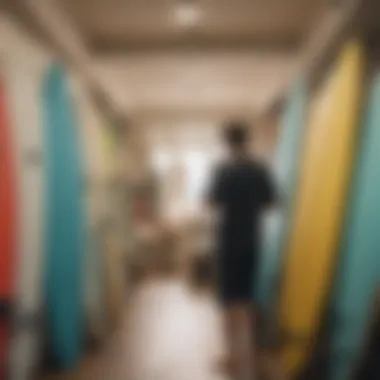

Soft Top Brands
Soft Top Brands, like Wavestorm and BIC, are excellent choices for beginners. Their soft tops reduce the risk of injury when falling, making it less intimidating for novice surfers. This characteristic is especially important during the initial learning phase, and contributes significantly to a beginner’s overall experience.
One unique feature of the Soft Top Boards is their buoyancy. It allows beginners to paddle out with less effort while ensuring plenty of flotation for catching waves. However, these boards might not perform as well as advanced options in bigger surf conditions. Regardless, they are excellent for honing basic skills.
Durable Models
Durability is another key consideration. Affordable durable models, such as those from NSP or South Bay Board Co., focus on resilience without the steep price tags. The construction materials used in these boards are often a bit tougher, making them resistant to dings and wear.
These boards can withstand mishaps that are likely to occur during practice. One of their standout features is how they handle varied wave conditions, offering a performance edge without a hefty price. On the downside, buyers may find these models slightly heavier, which might affect maneuverability for some beginners.
Entry-Level Performance Boards
For those ready to take it up a notch, entry-level performance boards from brands like Catch Surf and Torq cater specifically to aspirants wanting to push their limits. They often incorporate more advanced shapes and materials, aiding in balance and quicker turns.
These boards strike a great balance between performance and ease of use. One of their benefits is the versatility across different types of waves. However, the trade-off is often found in the price point; they can be a bit more expensive than the other options aimed purely at beginners.
Purchasing Your First Surfboard
When stepping into the surf world, buying the right surfboard is a monumental step. Acquiring your first surfboard can feel like one of those "now or never" moments in life. It’s not just about the board; it’s about launching yourself into an adventure that might just change your lifestyle. The choice can determine how quickly you catch waves or, conversely, how long it takes to grow as a surfer. This guide aims to shed light on the myriad aspects involved in purchasing your first surfboard, ensuring you make a decision that aligns with your skill level and surfing goals.
Buying Online versus Local Shops
In today's digital age, shopping online has become as common as grabbing a coffee. The convenience cannot be overstated; with a few clicks, a surfboard can be headed your way. However, local surf shops hold their charm. The beauty of buying from a local merchant is the opportunity to engage with seasoned surfers who can provide insights that might not be apparent through a screen. Local shops sometimes offer workshops or demo days, where new surfers can test equipment before laying down cash. Yet, online retailers often boast better prices or wider selections.
- Advantages of Buying Online:
- Advantages of Local Shops:
- Wider selection of brands and models.
- Potentially lower prices due to less overhead.
- Convenience of shopping from home.
- Personalized service and recommendations.
- Ability to physically inspect and test the board.
- Support local businesses and community.
So, whether you click away or stroll into a local treasure trove, weigh the pros and cons carefully.
What to Look for When Shopping
When embarking on this surfboard shopping journey, there are key factors that can make or break your experience. Pay attention to these aspects:
Test It Out
When you come to a shop and see a board that catches your eye, the best course of action is to test it out. Nothing compares to the feel of a board under your feet, as every surfer has their own preferences when it comes to dimensions and weight. Boards that work perfectly for others might not match your needs. Testing provides a sense of balance and buoyancy that just can't be understood through measurements alone. Surf shops often allow potential buyers to take boards for a spin, sometimes even in water nearby. This sort of hands-on experience is invaluable and significantly contributes to confidence in your selection.
Return Policies
Understanding return policies may not sound thrilling, but it is crucial in today’s shopping landscape. When you find your new surfboard online or in person, knowing what options are available can save you a headache down the line. If the board doesn’t feel right once you’re out on the water, could you return or exchange it? Many stores and online retailers have friendly policies that allow exchanges if the product hasn't been damaged. This feature can be a game-changer, giving you peace of mind as you make your selection. It’s best to check the fine print on return policies, as each vendor has their own specific rules, which may dictate timeframe and condition requirements.
"Purchasing your first surfboard is not just about the product itself but also about what it opens up for you as a surfer. Treat the process with care and humility."
In summary, when preparing to buy your first surfboard, consider the nuances between online and local purchases, examine return policies, and insist on testing boards where possible. Each choice carries implications not only for your shopping experience but for your future in the surf.
Remember, the best board isn’t necessarily the one that looks the fanciest but rather the one that feels right under your feet.
Caring for Your Surfboard
Caring for your surfboard is as essential as picking the right one when starting your surfing journey. Maintaining your board will ensure longevity and enhance your experience in the water. Investing time and effort into its upkeep means your surfboard can withstand the rigors of the ocean and continue to support you as you hone your skills.
A well-maintained surfboard can also improve your performance. Small nicks and scratches not only affect aesthetics but can alter how the surfboard rides. Therefore, adopting good care practices is vital for every beginner looking to make the most of their surfing adventures.
Proper Cleaning Practices
When it comes to cleaning your surfboard, it’s not as simple as giving it a quick rinse. After every surf session, it's a good practice to wash it down with fresh water. The ocean can leave behind salt and sand which over time may damage the board’s surface.
Here are some detailed steps to clean your surfboard properly:
- Rinse with Fresh Water: Start off by rinsing the board straight after getting back from the beach. This step helps remove any salt and debris.
- Use a Soft Cloth: Do not scrub harshly! A soft cloth or sponge is the best choice for wiping down the board. Gritty materials can create more scratches.
- Mild Soap if Necessary: If you need a little extra help, mix some mild soap with water. Ensure it’s nothing harsh that could strip the wax or paint away.
- Rinse Again: After your gentle scrubbing, it’s important you rinse your board one more time to avoid soap residue.
- Dry it Off: Finally, let the surfboard air dry before putting it away. This helps in preventing any moisture that could lead to mold.
"Keep your board clean, and it will be good to you. A little effort goes a long way in enjoying the waves!"
Storage Tips
How you store your surfboard is equally significant as cleaning it. Proper storage can protect your investment from dings, dents, and the sun’s damaging rays. Here are some ways to set your surfboard up for success in the off-hours:
- Indoor Storage: If possible, keep your surfboard indoors. This protects it from the elements and reduces chances of accidental impacts.
- Vertical vs. Horizontal: Storing your board vertically can save space and keep it safer from other objects falling on it. Just be sure it’s secured so it won’t tip over.
- Avoid the Sun: Extended exposure to sunlight can warp or fade your surfboard. If it’s not feasible to store indoors, consider using a surfboard sock or bag for added protection.
- Keep Away from Extreme Temperatures: Just like a car in summer heat, surfboards can’t stand excessive temperatures. Avoid storing them in hot attics or cold garages as these climates can cause damage over time.
- Check Regularly: Even stored boards need attention. A periodic check can help catch any developing issues before they become bigger problems.
Establishing a routine for both cleaning and storing your surfboard allows you to maximize its life cycle. Doing so will support your journey in surfing and keep your board feeling like new for the waves to come.
Getting Started: Lessons and Resources
Getting into surfing isn't just about picking out a surfboard and hitting the waves. It’s a journey that requires some preparation and guidance. This section sheds light on the significance of lessons and various resources available to beginners. Understanding how to surf properly can make a huge difference in your experience and your progression.
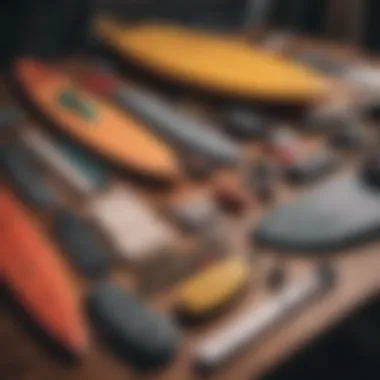
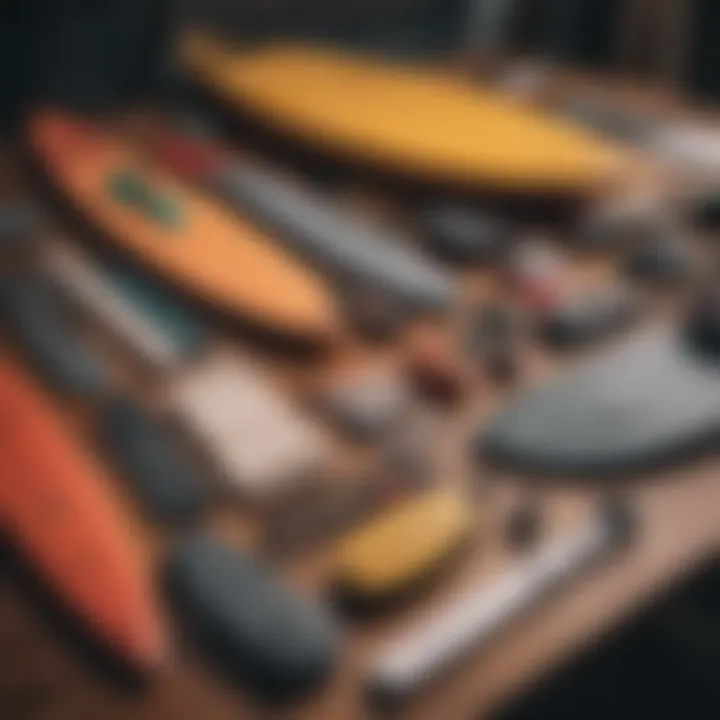
Finding Lessons
Many aspiring surfers often wonder, "Where do I even begin?" Well, starting off with professional lessons is a great way to dip your toes in the water, literally. Surfing can be tricky, what with all the paddling, balancing, and working with ocean currents.
Before you sign up for a class, consider a few vital factors:
- Local Surf Schools: Check out surf schools in your area. These schools often provide hands-on instruction tailored to your skill level. Instructors can offer immediate feedback and give you tips that you might miss trying to figure things out on your own.
- Group versus Private Lessons: Group lessons can be more affordable and offer a social aspect, but private lessons may give you personalized attention, accelerating your learning process.
- Level of Comfort: Make sure the instructors are certified and have a good reputation. A knowledgeable instructor can help you learn safety protocols, wave etiquette, and proper techniques when catching waves.
Also, check recreational programs offered at local beaches. Often community centers will have listings of available classes and schedules. It might feel like you’re signing up for a ride on the wild side, but investing in lessons pays off big time.
Online Resources and Communities
The internet is a treasure trove of information for beginners. Think of it as your expansive library where knowledge is only a click away. Here are some avenues worth exploring:
- Video Tutorials: Websites like YouTube are filled with instructional videos, covering everything from paddling techniques to wave dynamics. Watching experienced surfers can offer insights not easily conveyed in written formats.
- Surf Forums and Social Media: Engaging with communities on platforms like Reddit or Facebook can provide insights into other surfers' experiences. You can ask questions, share stories, and gain tips that are practical and real-world tested. These interactions can also help you find local surfing buddies.
- Apps and Online Courses: Consider downloading surfing apps. Some offer tutorials, surf forecasts, and even tracking tools to log your progress. Online courses from surfing experts can give you comprehensive lessons at your own pace, covering everything from techniques to mental preparation.
Building a Mindset for Surfing
When beginning your journey into surfing, developing the right mindset stands as foundational as selecting the right board. Surfing isn’t just a sport; it’s a lifestyle and a mental challenge. Having the right attitude can significantly affect not only how you learn but also how much you genuinely enjoy the experience.
Patience and Perseverance
Surfing may appear glamorous from the outside—picturesque waves, sunny days, and freedom on the water. However, underneath that surface lies countless hours of practice, patience, and a fair share of spills.
The ocean doesn't always cooperate. Waves might be too large or not big enough. Initially, you may find yourself struggling to stand, let alone catch a wave. It's essential to accept that everyone faces similar hurdles. Recognizing that failure is part of the learning process fosters resilience. Instead of seeing wipeouts as setbacks, view them as necessary stepping stones toward improvement. The grind of paddling out, positioning yourself correctly, and timing that perfect wave requires persistence. And let's be honest, embracing the ride—or sometimes the tumbles—will set you well on the course of mastering this sport.
"The master has failed more times than the beginner has ever tried."
It's crucial to remind yourself that each attempt is a lesson, and patience is your ally. Celebrate small victories, whether that’s balancing on your board or catching your first wave. Each day spent in the ocean chips away at the barriers you face.
Understanding Ocean Conditions
As you dive deeper into the world of surfing, developing an understanding of ocean conditions becomes key. The ocean can be unpredictable, changing with tides, winds, and weather patterns. Each surf session will present its own unique character, influenced by local conditions.
Being aware of this knowledge empowers you to make smarter choices about when and where to surf. Are the waves too harsh for beginners today? Is it safe or prudent to venture out? Familiarize yourself with terms like rip currents, tides, and wind direction. These factors can dictate your experience. Taking time to understand them not only keeps you safe but can enhance your time on the water.
- Check the local forecast and consult reliable surf reports—this can aid you in not only preparing physically but mentally as well.
- Engage with local surf communities, whether online or at the beach. Discussions with seasoned surfers often unveil valuable insights, allowing you to soak up firsthand experiences that a textbook can't teach.
Understanding the ocean isn't just about riding waves; it’s about fostering a respect for its might and intricacies. Engaging with the ocean on a deeper level transforms your outlook, guiding you to appreciate the natural environment.
Through patience, perseverance, and a solid grasp of ocean dynamics, beginners can develop a robust mindset essential for successful surfing. The journey may be challenging, but it is equally rewarding, promising adventures and fresh perspectives each time you find yourself on the water.
Navigating Local Surf Regulations
For beginners, the thrill of catching a wave can easily overshadow the need to understand local surf regulations. However, knowing these regulations is as crucial as picking the right surfboard. They are not just about the law but also about ensuring safety and respect within the surf community. Whether you’re carving through the Pacific or gliding on a lake, regulations vary significantly from one location to another. Familiarizing yourself with these rules will enhance your experience and provide a safer, more enjoyable surfing environment.
Respecting Surf Etiquette
One essential aspect of local regulations is respecting surf etiquette. Each surf spot comes with its own unwritten rules, much like how different countries have unique customs. Respecting these could mean the difference between a pleasant day on the water and a heated confrontation.
- Right of Way: In general, the surfer closest to the peak of the wave has the right of way. This means, if you're paddling for a wave and someone else is positioned to catch it first, it's best to let them go. It’s a simple courtesy that promotes harmony in the water.
- Dropping In: Never drop in on someone already riding a wave. This is considered offensive and can lead to dangerous situations.
- Communicating: If you're in doubt about a fellow surfer's intentions, a simple nod or wave can save a lot of confusion. It's all about fostering a community spirit.
Surf etiquette is not purely about following rules; it’s about creating a respectful surfing culture where everyone can enjoy the waves.
Safety Guidelines
Safety should always be at the forefront of any surfing expedition. Besides respecting surf etiquette, knowing safety guidelines can significantly reduce the risk of accidents.
- Know Your Environment: Understand the specifics of the surf break you are at, including tides, currents, and any hazardous conditions. It might be worth checking for local advisories or discussing conditions with seasoned surfers in the area.
- Wear the Right Gear: Depending on the climate and water temperature, wearing a wetsuit or rash guard can prevent injuries and discomfort. Even the best surfboard won't do you any good if you're unable to handle the elements.
- Stay Aware: Being attentive to your surroundings can help you avoid collisions with other surfers or underwater obstacles. Make sure to keep an eye on the horizon and stay close to the designated surfing areas.
Being an informed surfer isn't just about having fun; it's about being part of a community that respects each other and their shared ocean playground.
The End: Your Surfing Journey Begins
Starting your surfing journey can seem like a daunting task. However, it’s essential to recognize that each wave you ride and each tumble in the surf contributes to your learning experience. The conclusion of our guide emphasizes that the choices you've made regarding equipment and approach will set the tone for your adventure ahead. Proper preparation now can pave the way for countless enjoyable days catching waves in the future.
Reflecting on Your Choices
As you reflect on your surfboard choice, ask yourself what you've learned about your personal preferences and surfing goals. Did you prioritize stability over performance, choosing a soft top for those early attempts at balance? That decision is perfectly sound for a beginner. Each board has its strengths, and recognizing the features that suit your style will enhance your connection with the water.
A few points to ponder:
- Did you consider the cost versus the potential need for upgrades?
Invest in something durable but recognize that as you progress, you may want a new board that matches your advanced skills. - Have you thought about the local surf conditions?
Knowing whether you’ll be riding gentle waves or tackling more formidable breaks will influence your selection.
Making thoughtful choices doesn't have to be a solo endeavor. Reach out to other surfers or check out local forums to gain insights about what works best according to your environment. Connect with fellow surf enthusiasts on platforms like Reddit or even Facebook groups dedicated to surfing experiences to diversify your understanding.
Embracing the Experience
As you embrace your surfing journey, remember the waves offer both challenges and delightful experiences. Every splash of saltwater on your face can remind you of the joy found in persistence. Stress and frustrations are part of the learning curve, but so is the excitement of eventually riding your first wave without a fall.
It's not about perfecting your technique on the first try; rather, it's about soaking in the rhythmic dance of the ocean. Key elements to keep in mind as you embrace the adventure include:
- Keep an open mind.
Surfing is a blend of skill and intuition that requires time to develop. - Find your community.
Surround yourself with supportive surfers – they can motivate you during tough days and celebrate your triumphs when you finally catch that wave just right. - Enjoy the journey.
Take time to appreciate every moment, whether it’s on the board or just watching skilled surfers glide like seagulls across the horizon.
"Surfing is not just a sport. It’s a lifestyle, a way of thinking, and a passion that connects you to the earth and sea. Embrace it, and the rewards will follow."
Ultimately, this concluding section reminds you that every surfer’s path is unique. So board your chosen surfboard, paddle out, and let the adventure unfold. Your first wave is waiting, and with each attempt, you will become more comfortable on the water that has so much to offer.















